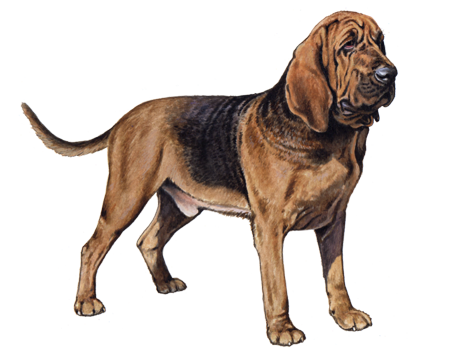
Bloodhound
Although Bloodhounds earn their reputation as amazing scent trackers, their gentle companionship makes them also an amazing family pet. They tend to be less energetic than other hounds, but they love being with their people and can also be great with kids.
Interested in discovering if your dog is a Bloodhound?
Check out Wisdom Panel's DNA tests.

Bloodhound Traits
General Appearance
These large dogs are known for their wrinkled faces and loose skin, with ears that droop and a set of warm, earnest eyes.
Coat and Colouring
The Bloodhound coat can vary in color between black and tan, liver and tan or red.
Distinctive Physical Traits
Bloodhounds are hard to miss, not only because of their foreboding size, but also their quintessential soulful eyes, thin skin that sags (particularly around the head and neck), droopy ears, and wrinkled face.
Bloodhound Temperament
The Bloodhound is known as an intelligent and affectionate breed. They make great companions for adults and kids alike, since they tend to be very gentle, patient, and good-natured. They can have a stubborn or independent streak, though.
For a hunting dog with a particular talent for scent trailing, the Bloodhound’s affectionate and gentle nature may surprise some. This breed gets along well with people and other dogs and can be shy and sensitive at times.
Bloodhounds do require daily activity, and it’s important to always keep them on a leash when in an unfamiliar or uncontained area, as their stubbornness and predilection to hunt can get the best of them. They’re also known to be very good diggers, easily escaping from areas that aren’t properly and securely fenced.


Bloodhound History
The father of all scent hounds, the Bloodhound originated in Belgium in 700 A.D., where they were bred to track game for hunting. They were a large part of the St. Hubert monastery, kept by everyone from monks to bishops to assist in tracking wolves, big cats, and deer. Following the Norman invasion in 1066, Bloodhounds made their way to England, where the black-and-tan variety became known as the Bloodhound as we see them today. The white variety—which became known as the Talbot Hound—is now extinct.
Throughout history, the Bloodhound has been used for everything from tracking and hunting animals to tracking missing people and criminals and assisting with drug searches. It’s estimated that a Bloodhound’s sense of smell is three million times better than that of human beings. Their tracking abilities have saved lives, and are so accurate that use of a Bloodhound’s nose will hold up in a court of law. The breed was introduced in the United States more than a century ago, where their love of tracking and performance has gained them a reputation as an excellent police dog.
Bloodhound Care
Nutrition
Bloodhounds require a high-quality dog food that is age-appropriate—whether it’s commercially manufactured or homemade (with a veterinarian’s supervision and approval). It’s important to monitor the amount of food you give your Bloodhound. Reduce the portions or restrict calories if your pup gains weight.
Your veterinarian is always a good source to help provide you with appropriate nutrition and feeding guidelines.
Grooming
Bloodhounds’ short, dense coats need to be brushed weekly to maintain overall health and remove loose hair, and they should be bathed regularly as well—paying particular attention to their folds—to avoid having dirt and debris build up.
All dogs require regular dental care, including at-home teeth brushing and professional dental cleanings, and the Bloodhound is no exception. Maintaining good dental hygiene is important for their overall long-term health.
Exercise
Though they may seem to operate in power-saver mode, this scent tracker is an active breed that requires plenty of daily exercise to stay happy and healthy. As a hound, any activity that involves hunting or chasing will be a favorite, but in the absence of that, even a nice long walk will suffice. Just remember to always keep Bloodhounds leashed when out and in unsecured areas, as their independent streak and love of tracking can get the best of them.
Training
Early and proper training is important for a Bloodhound, since this breed tends to have an independent and stubborn streak. These pups can also be sensitive at times, so they react well to positive rewards and praise. With a little patience and determination, training can be quite effective when handled properly.

Breed Group
Hound
The most common ancestral trait of this group is being used for hunting. Some use acute powers of scent to follow a trail while others demonstrate the gift of stamina as they run down a quarry. Beyond these two common traits, however, generalizations about hounds are hard to come by as the group is comprised of a very diverse lot of breeds.
Resources
https://www.akc.org/dog-breeds/bloodhound/
http://images.akc.org/pdf/breeds/standards/Bloodhound.pdf
Reviewed 26 July 2020 by Laura Inman, DVM


































